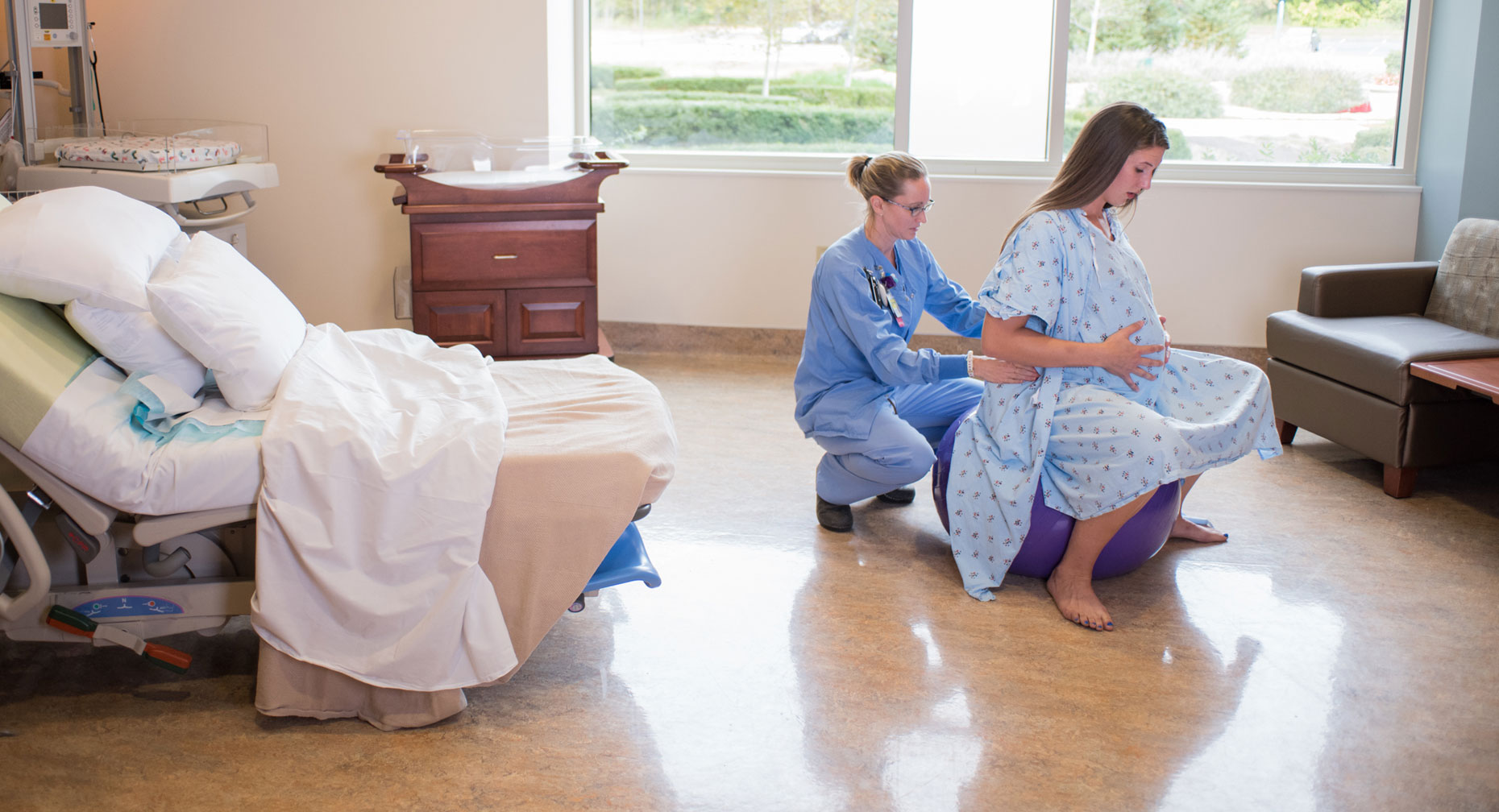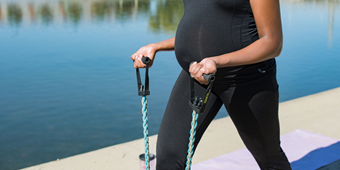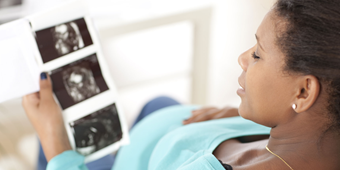Natural Childbirth: a Drug-Free Delivery

Find Your Perfect Match
Answer a few questions and we'll provide you with a list of primary care providers that best fit your needs.
Women choose natural childbirth to labor and deliver their babies without using pain medication. But that doesn’t mean without pain management. Many tactics including relaxation techniques and controlled breathing can help you ease the natural pain of natural birthing.
“When we talk about natural childbirth, we talk about it being very much like preparing for a marathon,” says Stacy Hudepohl, certified nurse midwife, Center for Women’s Health and Wellness of Mason. “It’s 50 percent physical and 50 percent mental.”
To prepare for natural childbirth you can:
- Get your body in shape to build endurance
- See your doctor for all prenatal appointments
- Create a support team that includes your partner, a friend, dula or midwife
- Have a mentor who can offer advice about natural childbirth
- Take childbirth classes
“It’s about doing that physical and mental preparation that you would do for any major event your body will undergo,” Hudepohl says.
Pain During Labor and Delivery
Each woman feels the pain of labor and delivery differently. The amount of pain a woman feels depends on the size and position of the baby, the size of the woman’s pelvis, the strength of her contractions and her emotions and outlook.
The actions your body takes to deliver your baby cause you to feel pain. Contractions of the muscles of the uterus and pressure on the cervix cause uncomfortable sensations. You may feel strong cramping or an achy feeling in your abdomen, groin or back. Some women may feel pain in their sides or thighs.
Each woman feels the pain of labor and delivery differently
Pressure on the bladder and bowels caused by the baby’s head and the stretching of the birth canal and vagina may also cause pain.
The more you prepare for labor and delivery, the better equipped you will be to manage your pain.
Exercise. Regular and safe exercise will strengthen your muscles and build your endurance so that your body will be more prepared if you have a long labor. Be sure to talk with your doctor about a safe exercise plan for you and your baby during pregnancy.
Childbirth classes. Classes teach you and your partner how to prepare for your child’s arrival. They help remove the fear factor and teach different approaches to pain management, such as the Lamaze and Bradley methods. All childbirth classes also address the use of pain medication and provide the information you need to decide if it is right for you. Childbirth classes also discuss what happens if a cesarean section becomes necessary.
“Childbirth classes are vital to a first-time mom to help with that mental portion of natural birth,” Hudepohl says.
Class offerings vary depending on what the couple wants. There are 1-day sessions, 3-month classes and workshops that focus on traditional childbirth, the use of epidurals, involving family members in the birth of the baby and sibling classes.
 Midwives: Your Partner for Natural Childbirth
Midwives: Your Partner for Natural Childbirth
A midwife can also assist with pain relief during natural childbirth.
“Midwives tend to spend more time with women when they are in labor,” Hudepohl says. “They will be at the bedside a lot more.”
Midwives are highly experienced with the natural course of labor, and they closely monitor a woman as she progresses toward delivery. This is essential because different pain management therapies, such as hydrotherapy, work best at different stages of labor, Hudepohl says.
A midwife also can suggest different techniques for easing pain based on the baby’s position. This can aid with back labor or labor pain in the legs.
Natural Pain Relief Methods
There are many different ways to manage labor pain without medicine. When you are at home during early labor, movements like walking and rocking in a rocking chair, massage and a shower or soak in the tub can help relax your muscles and keep your mind off of the contractions.
Hudepohl says it is important to remember to conserve your energy during early labor. Once you begin active labor, the use of different birthing balls or stools can ease the pain.
Hydrotherapy works best during active labor. It takes your mind off the pain. A jetted tub or shower helps to relax muscles and offers mental and physical relief. The buoyancy of being in the water helps you feel less heavy and this feeling of weightlessness helps reduce fatigue.
Other common methods for pain relief during natural childbirth include:
- Meditation
- Yoga
- Breathing techniques
- Walking
- Massage
- Changing position
- Using heat on the lower back and cold on the forehead
- Using a labor ball
- Listening to music
- Aromatherapy
- Hypnosis
Women should discuss their preferred pain relief methods with their doctor before labor begins. This will ensure an understanding of the options, risk and benefits of different labor and delivery pain relief methods.
Water Birth: Another Delivery Option
The ability to have a water birth is now an option in Dayton and Cincinnati. An increasing number of women are using hydrotherapy and water birth, says the federal Office on Women’s Health. Water birth allows you to deliver your baby directly into warm water.
“This is a natural process,” Hudepohl says. “Babies are in water in the amniotic sac so coming into water is more natural. They come from one warm water environment into another one.”
Water birth also eases pressure placed on mom’s body during pushing and delivery and can help reduce tearing.
Questions to Ask When Planning Your Labor and Delivery
As you start to create a plan for your baby’s birth, be sure to talk with your doctor early about the kind of delivery you want to have.
“The most important advice I can give is don’t wait to bring up the types of things you want,” Hudepohl says. “Don’t wait to find out that your doctor will not support you.”
When you discuss your plans with your doctor, everyone on your support team will have the same expectations, which will make the entire process go smoother.
Here are some questions to ask your doctor:
- When will you come see me during my labor?
- What is the episiotomy rate at this hospital?
- What is the C-section rate?
- How do you feel about natural childbirth?
- Do you support hydrotherapy?
- Will you support me in my plans for a medication-free labor and delivery?
- Can I have a water birth?
A comfortable level of trust is essential between moms-to-be and their doctors, to ensure the best and safest birth experience possible, Hudepohl says. “The trust needs to go both ways so that there can be open dialogue.”
Changing Your Mind About Pain Medicine
What happens if you planned a medication-free delivery but you change your mind? Just ask for the medication, and you will get it, Hudepohl says.
“Every midwife will tell you that we want the birth that you want,” Hudepohl says. “If you want pain medicine, that is 100 percent fine. We are there to listen to you and make sure we have a healthy mom and a healthy baby.”
Hudepohl says she wants to disprove the myth that epidurals can only be given early in labor. She says, “As long as a woman can listen to the directions of the anesthesia team and can hold still, there is really not a time that she can’t have an epidural during labor.”
Find Your Perfect Match
Answer a few questions and we'll provide you with a list of primary care providers that best fit your needs.
Source: Stacy Hudepohl, CNM, MSN, Center for Women’s Health and Wellness; Department of Health and Human Service’s Office on Women’s Health; American Academy of Family Physicians




